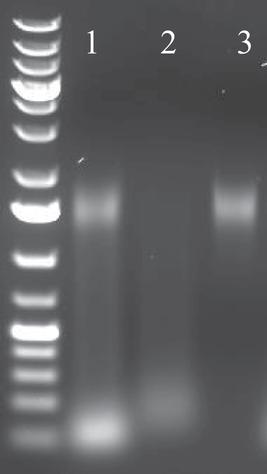下载PDF
{"title":"STARR-seq和uni -STARR-seq:评估全基因组、高复杂性和低复杂性候选文库的增强子活性","authors":"Christoph Neumayr, Michaela Pagani, Alexander Stark, Cosmas D. Arnold","doi":"10.1002/cpmb.105","DOIUrl":null,"url":null,"abstract":"<p>The identification of transcriptional enhancers and the quantitative assessment of enhancer activities is essential to understanding how regulatory information for gene expression is encoded in animal and human genomes. Further, it is key to understanding how sequence variants affect enhancer function. STARR-seq enables the direct and quantitative assessment of enhancer activity for millions of candidate sequences of arbitrary length and origin in parallel, allowing the screening of entire genomes and the establishment of genome-wide enhancer activity maps.</p><p>In STARR-seq, the candidate sequences are cloned downstream of the core promoter into a reporter gene's transcription unit (i.e., the 3′ UTR). Candidates that function as active enhancers lead to the transcription of reporter mRNAs that harbor the candidates’ sequences. This direct coupling of enhancer sequence and enhancer activity in <i>cis</i> enables the straightforward and efficient cloning of complex candidate libraries and the assessment of enhancer activities of millions of candidates in parallel by quantifying the reporter mRNAs by deep sequencing. This article describes how to create focused and genome-wide human STARR-seq libraries and how to perform STARR-seq screens in mammalian cells, and also describes a novel STARR-seq variant (UMI-STARR-seq) that allows the accurate counting of reporter mRNAs for STARR-seq libraries of low complexity. © 2019 The Authors.</p><p><b>Basic Protocol 1</b>: STARR-seq plasmid library cloning</p><p><b>Basic Protocol 2</b>: Mammalian STARR-seq screening protocol</p><p><b>Alternate Protocol</b>: UMI-STARR-seq screening protocol—unique molecular identifier integration</p><p><b>Support Protocol</b>: Transfection of human cells using the MaxCyte STX scalable transfection system</p>","PeriodicalId":10734,"journal":{"name":"Current Protocols in Molecular Biology","volume":"128 1","pages":""},"PeriodicalIF":0.0000,"publicationDate":"2019-09-09","publicationTypes":"Journal Article","fieldsOfStudy":null,"isOpenAccess":false,"openAccessPdf":"https://sci-hub-pdf.com/10.1002/cpmb.105","citationCount":"32","resultStr":"{\"title\":\"STARR-seq and UMI-STARR-seq: Assessing Enhancer Activities for Genome-Wide-, High-, and Low-Complexity Candidate Libraries\",\"authors\":\"Christoph Neumayr, Michaela Pagani, Alexander Stark, Cosmas D. Arnold\",\"doi\":\"10.1002/cpmb.105\",\"DOIUrl\":null,\"url\":null,\"abstract\":\"<p>The identification of transcriptional enhancers and the quantitative assessment of enhancer activities is essential to understanding how regulatory information for gene expression is encoded in animal and human genomes. Further, it is key to understanding how sequence variants affect enhancer function. STARR-seq enables the direct and quantitative assessment of enhancer activity for millions of candidate sequences of arbitrary length and origin in parallel, allowing the screening of entire genomes and the establishment of genome-wide enhancer activity maps.</p><p>In STARR-seq, the candidate sequences are cloned downstream of the core promoter into a reporter gene's transcription unit (i.e., the 3′ UTR). Candidates that function as active enhancers lead to the transcription of reporter mRNAs that harbor the candidates’ sequences. This direct coupling of enhancer sequence and enhancer activity in <i>cis</i> enables the straightforward and efficient cloning of complex candidate libraries and the assessment of enhancer activities of millions of candidates in parallel by quantifying the reporter mRNAs by deep sequencing. This article describes how to create focused and genome-wide human STARR-seq libraries and how to perform STARR-seq screens in mammalian cells, and also describes a novel STARR-seq variant (UMI-STARR-seq) that allows the accurate counting of reporter mRNAs for STARR-seq libraries of low complexity. © 2019 The Authors.</p><p><b>Basic Protocol 1</b>: STARR-seq plasmid library cloning</p><p><b>Basic Protocol 2</b>: Mammalian STARR-seq screening protocol</p><p><b>Alternate Protocol</b>: UMI-STARR-seq screening protocol—unique molecular identifier integration</p><p><b>Support Protocol</b>: Transfection of human cells using the MaxCyte STX scalable transfection system</p>\",\"PeriodicalId\":10734,\"journal\":{\"name\":\"Current Protocols in Molecular Biology\",\"volume\":\"128 1\",\"pages\":\"\"},\"PeriodicalIF\":0.0000,\"publicationDate\":\"2019-09-09\",\"publicationTypes\":\"Journal Article\",\"fieldsOfStudy\":null,\"isOpenAccess\":false,\"openAccessPdf\":\"https://sci-hub-pdf.com/10.1002/cpmb.105\",\"citationCount\":\"32\",\"resultStr\":null,\"platform\":\"Semanticscholar\",\"paperid\":null,\"PeriodicalName\":\"Current Protocols in Molecular Biology\",\"FirstCategoryId\":\"1085\",\"ListUrlMain\":\"https://onlinelibrary.wiley.com/doi/10.1002/cpmb.105\",\"RegionNum\":0,\"RegionCategory\":null,\"ArticlePicture\":[],\"TitleCN\":null,\"AbstractTextCN\":null,\"PMCID\":null,\"EPubDate\":\"\",\"PubModel\":\"\",\"JCR\":\"Q2\",\"JCRName\":\"Biochemistry, Genetics and Molecular Biology\",\"Score\":null,\"Total\":0}","platform":"Semanticscholar","paperid":null,"PeriodicalName":"Current Protocols in Molecular Biology","FirstCategoryId":"1085","ListUrlMain":"https://onlinelibrary.wiley.com/doi/10.1002/cpmb.105","RegionNum":0,"RegionCategory":null,"ArticlePicture":[],"TitleCN":null,"AbstractTextCN":null,"PMCID":null,"EPubDate":"","PubModel":"","JCR":"Q2","JCRName":"Biochemistry, Genetics and Molecular Biology","Score":null,"Total":0}
引用次数: 32
引用
批量引用
STARR-seq and UMI-STARR-seq: Assessing Enhancer Activities for Genome-Wide-, High-, and Low-Complexity Candidate Libraries
The identification of transcriptional enhancers and the quantitative assessment of enhancer activities is essential to understanding how regulatory information for gene expression is encoded in animal and human genomes. Further, it is key to understanding how sequence variants affect enhancer function. STARR-seq enables the direct and quantitative assessment of enhancer activity for millions of candidate sequences of arbitrary length and origin in parallel, allowing the screening of entire genomes and the establishment of genome-wide enhancer activity maps.
In STARR-seq, the candidate sequences are cloned downstream of the core promoter into a reporter gene's transcription unit (i.e., the 3′ UTR). Candidates that function as active enhancers lead to the transcription of reporter mRNAs that harbor the candidates’ sequences. This direct coupling of enhancer sequence and enhancer activity in cis enables the straightforward and efficient cloning of complex candidate libraries and the assessment of enhancer activities of millions of candidates in parallel by quantifying the reporter mRNAs by deep sequencing. This article describes how to create focused and genome-wide human STARR-seq libraries and how to perform STARR-seq screens in mammalian cells, and also describes a novel STARR-seq variant (UMI-STARR-seq) that allows the accurate counting of reporter mRNAs for STARR-seq libraries of low complexity. © 2019 The Authors.
Basic Protocol 1 : STARR-seq plasmid library cloning
Basic Protocol 2 : Mammalian STARR-seq screening protocol
Alternate Protocol : UMI-STARR-seq screening protocol—unique molecular identifier integration
Support Protocol : Transfection of human cells using the MaxCyte STX scalable transfection system



